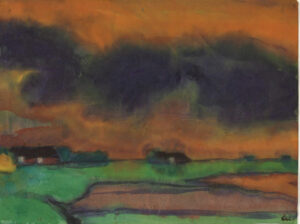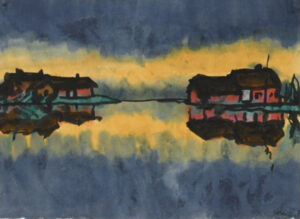Emil Nolde was a German-Danish painter and printmaker. He was one of the first Expressionists, which is a style of painting that occurred during the modernist movement. Expressionism gained popularity in the 20th century and was predominantly popular in Germany. The style of art is subjective to the artist’s own perspective, especially emotionally. Many expressionist painters were influenced by Vincent Van Gogh due to common features in painting including shocking composition and unpredictable coloring.
The art piece that I am introducing is a painting called, Marsh Landscape by Emil Nolde. This art piece was inspired by Nolde’s life on the Baltic coast of Germany and created sometime between 1930-1935. The landscape in the painting was a low-lying marsh specifically located at the border province of North Schleswig where he was born and raised. Nolde has created quite a few landscape paintings of the marshes because the setting held special meaning to him since it was the place he was raised in.
The art piece is a great example of Emil Nolde’s talent as an expressionist painter. The painting has many different sizes of brush strokes and colors. There are many aspects of nature in this painting but not in its typical form. The sky is depicted using a different color than it is usually depicted, here the sky is orange and has dark purple like clouds. By using colors that are not “typical”, Nolde is expressing himself in the painting rather than the physical reality of the landscape.
From this painting we can learn that a lot of the “realities” we feel in nature are based on perspective. The way Emil Nolde is able to capture emotion out of this landscape and paint it allows people viewing the art to understand his “reality” instead. People often forget about their emotional connection to nature and often refer back to nature regarding science. However, from this painting we learn that a lot of the things we visualize are based on the emotions and perspectives we feel.

The image shows the painting Marsh Land painted during the 1930s
Emil Nolde (1930-1935), Marsh Land, North Schleswig
https://www.clevelandart.org/art/2011.125

The image shows the painting Marsh Land painted during the 1930s
Emil Nolde (1930-1935), Marsh Land, North Schleswig
https://www.stephenongpin.com/object/790427/18216/marsh-landscape-with-farmhouses-at
